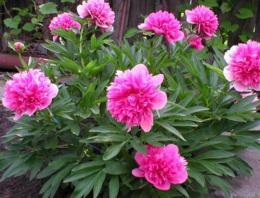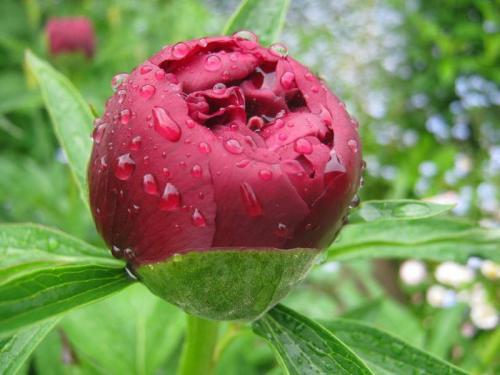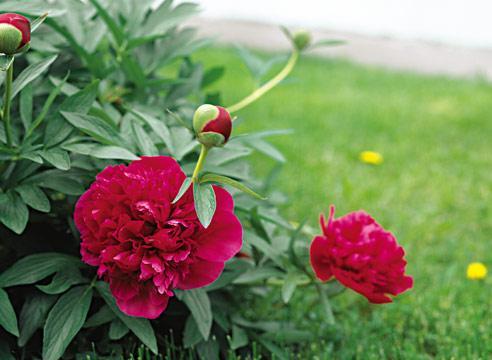Planting peonies in spring: responsible, risky, but quite doable

Peonies are an excellent decoration for a garden plot. Thrifty owners know that the best time to plant them is autumn. But is everything so hopeless in the spring?
Content
- What should gardeners fear in the spring?
- How to properly handle crops in spring?
- Planting requirements and bush care
What should gardeners fear in the spring?
The period from August to September is considered the most favorable for planting flower culture. Spring work is fraught with some difficulties: the peony may get sick, since the buds have begun to actively grow; high probability of death of transplanted plants due to unfavorable conditions.
Often planting peonies at this time of year is a necessary measure. Many varieties are brought from other countries in late February and early March. They appear on store shelves, seducing both beginners and experienced gardeners. Connoisseurs of this lush beauty want to acquire a new type of crop, but their souls are gnawed by doubts: what if the fragile plant dies before being planted in the garden or suffers from bad weather?
An incorrectly planted peony will develop poorly in the spring and get sick in the first years. Temperature plays an important role. If it’s +20…+30C outside, then white suction roots begin to appear on the plant. With sudden warming, the buds begin to grow and the flower actively develops.
During this period, the roots are significantly behind in growth from the green above-ground mass. Young shoots suck the strength from the rhizome: the plant is depressed.
When is it necessary to plant a plant in this unfavorable period, experienced gardeners advise you to hurry up. Both tree and herbaceous peonies are planted in early spring, as soon as the snow melts and the soil thaws. In the temperate climate zone, such conditions are created in early April.
How to properly handle crops in spring?

Dividing the bush. One way to plant peonies:
- Prepare holes 70 cm deep and 60 cm in diameter. The distance between each hole is at least 1 m.
- Create a drainage layer at the bottom: gravel or broken brick.
- On top is a ball of humus with potassium fertilizers and superphosphates. Half of the recess should be filled.
- Next, the soil is sprinkled and the flower is planted to a depth of 10 cm. The roots are carefully straightened, the buds are deepened several centimeters into the ground.
- Make a hole around the plant and water generously. Sprinkle the remaining soil on top for protection.
If the weather prevents planting peonies in the spring directly into the flowerbed, then they can be placed in pots and stored at temperatures from 00 to +20C. When new shoots appear, provide plenty of light and care for the plant as if it were an indoor plant.
Bushes are planted in the ground after the weather becomes consistently warm.
Reproduction by layering. The peony is covered with a box without a bottom (width - 50 cm, height - 40 cm, length - 50 cm). Moist soil is poured into it. The bush will develop, roots and renewal buds will form on the stems. Having waited until autumn, you need to cut off the shoots above the new buds and continue to care for them in the nursery.
Correct preparatory actions before landing, favorable weather conditions
Planting requirements and bush care

Peonies are long-lived. If the owners show them attention and care, then lush flowers will delight you for decades. Experienced gardeners know what a plant needs:
- Loamy soil and good drainage. When the soil is peaty, the soil in the hole is changed when planting. Peat should be added to clay or sandy soil. You can replace it with humus.
- Slaked lime will make acidic soil more suitable for peonies (250 g per bush).
- The roots will begin to rot if the flowers are planted in a low-lying area or in a place with high humidity.
- The proximity of the house will cause excessive heating of the crop. The walls of the home, especially
- wooden, emit heat: the peony may die.
In the shade the bush will not grow well and will not produce many flowers. The soil in the new hole will definitely settle, so there is no need to deepen the buds too much. If they are more than 20 cm underground, there will be no flowers. Sun, protection from the wind, light shade at midday - this is what peony loves.
In the first year after planting, the bush requires special treatment. It's necessary water on time, weed and prevent flowering to make the plant strong. When a peony doesn’t have enough water, underdeveloped buds form on it: flowering will not be complete. In 5 years, the root system of a healthy crop goes 50 cm deep into the soil and grows in diameter by the same amount.
Attention from gardeners to a peony planted in spring ensures that the plant will delight the eye for decades.
There is no need to be afraid to plant peonies in the spring. If you approach the matter responsibly and arm yourself with knowledge, bright flowers will become a worthy decoration of the garden.
Watch how to plant peonies in the video:
Interesting information about the vegetable garden











Comments
Thank you for such a detailed article on planting and caring for peonies. I was just thinking about planting several multi-colored peony bushes in a city flowerbed in the courtyard of the house. Now the problem has been resolved - I will definitely plant it in the next couple of weeks.
I love peonies. Such beautiful and colorful flowers. And they smell so nice... I will squeeze them next spring.